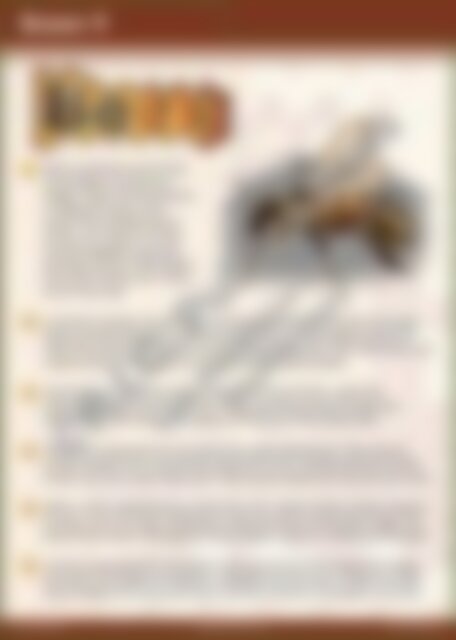- Page 1 and 2:
Red 1 1 2 3 4 5 Pets are animals we
- Page 3 and 4:
Red 2 Knock! Knock! 1 2 3 4 Knock,
- Page 5 and 6:
Red 3 1 2 3 Next Monday it’s my b
- Page 7 and 8:
Red 4 Nugget and Clucky 1 2 3 4 5 6
- Page 9 and 10:
Red 5 1 2 3 4 5 6 7 Eeek! Dragon! O
- Page 11 and 12:
Red 6 1 2 3 4 5 Merrick, the mud mo
- Page 13 and 14:
Red 7 1 2 3 4 Legend of Muda, the p
- Page 15 and 16:
Red 8 1 2 3 4 5 6 7 Batty bats Bats
- Page 17 and 18:
Red 9 How the elephant got its trun
- Page 19 and 20:
Red 10 1 2 3 4 5 The mystery of the
- Page 21 and 22:
Card 1 Yellow 1 1 2 3 4 big elephan
- Page 23 and 24:
Yellow 2 1 2 3 4 Llamas are animals
- Page 25 and 26:
Yellow 3 1 2 3 4 5 Once upon a time
- Page 27 and 28:
Yellow 4 1 2 Teddy bears There’s
- Page 29 and 30:
Yellow 5 Birthday wish 1 2 3 4 5 It
- Page 31 and 32:
Yellow 6 1 2 3 4 5 6 Hi. My name is
- Page 33 and 34:
Yellow 7 1 2 3 4 5 6 Tick! Tock! Sq
- Page 35 and 36:
Yellow 8 1 2 3 4 5 Jenny and Mum ma
- Page 37 and 38:
Yellow 9 In the land of Nuts and Bo
- Page 39 and 40:
Yellow 10 Floating egg tricks If yo
- Page 41 and 42:
Blue 1 1 2 3 4 5 6 7 Beetle’s adv
- Page 43 and 44:
Blue 2 What’s for breakfast? 1 2
- Page 45 and 46:
Blue 3 1 2 3 4 The girl who could t
- Page 47 and 48:
Blue 4 1 2 3 4 Hi! I’m Kyle. I ha
- Page 49 and 50:
Blue 5 1 2 3 4 Tarantulas Tarantula
- Page 51 and 52:
Blue 6 1 2 3 4 First, I was thrown
- Page 53 and 54:
Blue 7 2 4 Four different dinosaurs
- Page 55 and 56:
Blue 8 Protecting firefighters 1 2
- Page 57 and 58:
Blue 9 6 Silky silkworms Did you kn
- Page 59 and 60:
Blue 10 1 2 3 4 The world’s talle
- Page 61 and 62:
Orange 1 How to stop me bugging you
- Page 63 and 64:
Orange 2 1 2 3 4 5 6 Floss, the too
- Page 65 and 66:
Orange 3 1 2 3 Popcorn is a food th
- Page 67 and 68:
Orange 4 1 2 3 4 5 I used to ask Mu
- Page 69 and 70:
Orange 5 1 2 3 4 5 Dolphins Dolphin
- Page 71 and 72:
Orange 6 The Loch Ness monster 1 Lo
- Page 73 and 74:
Red 7 Orange 7 1 2 Once there was a
- Page 75 and 76:
Orange 8 1 2 3 Quicksand Maybe you
- Page 77 and 78:
Orange 9 1 2 3 4 5 The wonder of wo
- Page 79 and 80:
Orange 10 Dolphin daze 1 2 3 4 5 6
- Page 81 and 82:
Green 1 1 2 3 4 5 6 Titanic was a b
- Page 83 and 84:
Green 2 The biggest animal on Earth
- Page 85 and 86: Green 3 Go Blue! 1 2 3 4 5 Each yea
- Page 87 and 88: Green 4 1 2 3 4 5 hat hall we call
- Page 89 and 90: Green 5 Raptor When we think of din
- Page 91 and 92: Green 6 1 2 3 4 5 Thousands of year
- Page 93 and 94: Red Green 7 7 1 2 3 4 5 The monster
- Page 95 and 96: Green 8 You will need: • a coin
- Page 97 and 98: Green 9 Time machine 1 2 3 4 5 6 7
- Page 99 and 100: Green 10 Because an ant got mad 1 O
- Page 101 and 102: Purple 1 The wind and the sun 1 2 3
- Page 103 and 104: Purple 2 1 2 3 4 5 6 7 You need: 1
- Page 105 and 106: Purple 3 1 2 3 4 5 Cloud spotting C
- Page 107 and 108: Purple 4 1 2 3 4 5 6 Cows have one
- Page 109 and 110: Purple 5 1 2 3 4 5 Upside-down hous
- Page 111 and 112: Purple 6 1 2 3 4 5 A natural satell
- Page 113 and 114: Red 7 Purple 7 Cat alarm 1 2 3 4 5
- Page 115 and 116: Card 58 Purple 8 Computer curse 1 2
- Page 117 and 118: Bells, Dick Whittington and his cat
- Page 119 and 120: Purple 10 1 2 3 4 5 6 Snakes are re
- Page 121 and 122: Brown 1 1 2 3 4 5 The wolf in sheep
- Page 123 and 124: Brown 2 1 2 3 4 5 Marvellous mucus
- Page 125 and 126: Brown 3 1 2 3 4 5 6 The oxygen cycl
- Page 127 and 128: Brown 4 1 2 3 4 5 Blobfish Have you
- Page 129 and 130: Brown 5 Banana recipes 1 Banana flu
- Page 131 and 132: Brown 6 1 2 3 4 5 6 I am a bully. I
- Page 133 and 134: Red Brown 7 7 A very different plac
- Page 135: Brown 8 Bad boy, Butch 1 2 3 4 5 6
- Page 139 and 140: Brown 10 What is an island? Bishop
- Page 141 and 142: Black 1 1 2 3 4 Fire! Fire! Fire! F
- Page 143 and 144: Black 2 Streets of water 1 2 3 Can
- Page 145 and 146: Black 3 Sun bears 1 2 3 4 5 The sun
- Page 147 and 148: Black Black 4 4 1 2 3 4 5 6 Playing
- Page 149 and 150: Black 5 Down with electronic games!
- Page 151 and 152: Black 6 1 2 3 4 5 Wonderful mermaid
- Page 153 and 154: Black 7 1 2 3 4 5 Merry-go-rounds h
- Page 155 and 156: Black 8 1 2 3 4 5 Skipping is a gre
- Page 157 and 158: Black 9 Enchanting unicorns 1 2 3 4
- Page 159 and 160: Black 10 1 2 3 4 5 6 nostrils mouth
- Page 161 and 162: Lime 1 The legend of Black Bart 1 2
- Page 163 and 164: Lime 2 It’s not for sale! 1 3 5 I
- Page 165 and 166: Lime 3 Have you ever seen raisins w
- Page 167 and 168: Lime 4 1 2 3 4 5 6 7 Living with th
- Page 169 and 170: Lime 5 Limerick fun The poems below
- Page 171 and 172: Lime 6 It’s not what really happe
- Page 173 and 174: Lime 7 1 2 3 4 5 The Earth’s slow
- Page 175 and 176: Lime 8 1 2 3 4 5 6 Invisible paint
- Page 177 and 178: Lime 9 1 2 3 4 5 6 7 Hiccup! Hiccup
- Page 179 and 180: Lime 10 1 2 3 4 5 6 7 issun-Boshi,
- Page 181 and 182: Grey 1 1 2 3 4 5 6 7 8 Rainbows in
- Page 183 and 184: Grey 2 Slugs and snails 1 2 3 4 5 S
- Page 185 and 186: Card 93 Grey 3 1 2 3 4 5 Moths and
- Page 187 and 188:
Grey 4 1 2 3 4 5 First trip to the
- Page 189 and 190:
Learn about the library 1 2 3 4 5 6
- Page 191 and 192:
Grey 6 Tall poppies 1 flower buds 4
- Page 193 and 194:
Red 7 Grey 7 1 2 3 4 5 Pirates ahoy
- Page 195 and 196:
Grey 8 1 2 3 4 5 6 Newborn kittens
- Page 197 and 198:
Grey 9 How do you make a balloon ma
- Page 199 and 200:
Grey 10 A river walk 1 2 3 4 5 6 If
- Page 201 and 202:
Pink 1 1 2 3 4 5 6 Mighty moose In
- Page 203 and 204:
Pink 2 1 2 3 4 5 6 7 You’ll never
- Page 205 and 206:
Pink 3 This is how Indigenous Austr
- Page 207 and 208:
Pink 4 1 2 3 4 5 6 7 Bring back wri
- Page 209 and 210:
Pink 5 1 2 3 4 5 Dear Mrs Jones Did
- Page 211 and 212:
Pink 6 1 2 3 4 5 6 7 Danger on the
- Page 213 and 214:
Pink 7 Canteen food - Good or bad?
- Page 215 and 216:
Pink 8 1 2 3 4 5 6 Are prairie dogs
- Page 217 and 218:
Pink 9 You will need: l 1 small tub
- Page 219 and 220:
Pink 10 1 2 3 4 5 The first sandwic
- Page 221 and 222:
Lemon 1 1 2 3 4 5 6 7 Laszlo Biro
- Page 223 and 224:
Lemon 2 1 2 3 4 5 6 7 8 9 Mrs Crank
- Page 225 and 226:
Lemon 3 1 2 3 4 Egypt is famous for
- Page 227 and 228:
Lemon 4 1 2 3 4 5 Does a huntsman h
- Page 229 and 230:
Part human, part animal Lemon 5 3 4
- Page 231 and 232:
Lemon 6 1 2 3 4 5 Was T. rex the ki
- Page 233 and 234:
Lemon 7 1 2 3 4 5 6 The porridge po
- Page 235 and 236:
Lemon 8 1 2 3 4 5 Faster than sound
- Page 237 and 238:
Lemon 9 1 2 3 4 5 6 7 8 9 10 11 For
- Page 239 and 240:
Lemon 10 1 2 3 4 5 6 7 8 The loose-
- Page 241 and 242:
Mauve 1 1 2 3 4 Wiley Wolf Dear Mrs
- Page 243 and 244:
Mauve 2 Great homework excuses Some
- Page 245 and 246:
Mauve 3 Crazy Horse 1 2 3 4 5 Crazy
- Page 247 and 248:
Mauve 4 1 2 3 4 5 6 7 8 bears! Ever
- Page 249 and 250:
Mauve 5 1 2 3 4 5 6 7 Do you have a
- Page 251 and 252:
Mauve 6 Birds that can’t fly 1 2
- Page 253 and 254:
Mauve 7 1 2 3 4 5 6 7 Dragon + fly
- Page 255 and 256:
Mauve 8 1 2 3 4 5 6 Reading by touc
- Page 257 and 258:
Mauve 9 1 2 3 4 5 6 7 Elephant and
- Page 259 and 260:
Mauve 10 1 2 3 4 5 6 A dragon Doug
- Page 261 and 262:
Silver 1 1 2 3 4 5 6 7 Have you hea
- Page 263 and 264:
Silver 2 Making marshmallows Ingred
- Page 265 and 266:
Silver 3 Dr Dolittle’s adventures
- Page 267 and 268:
Silver 4 1 2 3 4 7 8 Horse ballet C
- Page 269 and 270:
Silver 5 1 2 3 4 5 6 Mum and Dad lo
- Page 271 and 272:
Silver 6 1 2 3 4 5 6 7 8 9 10 11 Ry
- Page 273 and 274:
Silver 7 Lambing season 1 2 3 4 5 L
- Page 275 and 276:
Silver 8 1 2 3 4 5 The real Pinocch
- Page 277 and 278:
Silver 9 1 2 3 4 5 6 7 The tortoise
- Page 279 and 280:
Silver 10 1 2 3 4 5 6 7 8 Androcles
- Page 281 and 282:
Gold 1 How a hot-air balloon works
- Page 283 and 284:
Gold 2 1 2 3 4 Amazing animals Did
- Page 285 and 286:
Gold 3 1 2 3 4 5 Skin - the body’
- Page 287 and 288:
Gold 4 1 2 3 4 5 People use the ter
- Page 289 and 290:
Gold 5 Green sea 1 2 3 turtle The g
- Page 291 and 292:
Gold 6 1 2 3 4 Batter up for tee-ba
- Page 293 and 294:
Gold 7 1 2 3 4 World records A worl
- Page 295 and 296:
Gold 8 1 2 3 LEGO ® The colourful
- Page 297 and 298:
Gold 9 Ingredients • 1 cup nuts
- Page 299 and 300:
Gold 10 description activity diet d


















